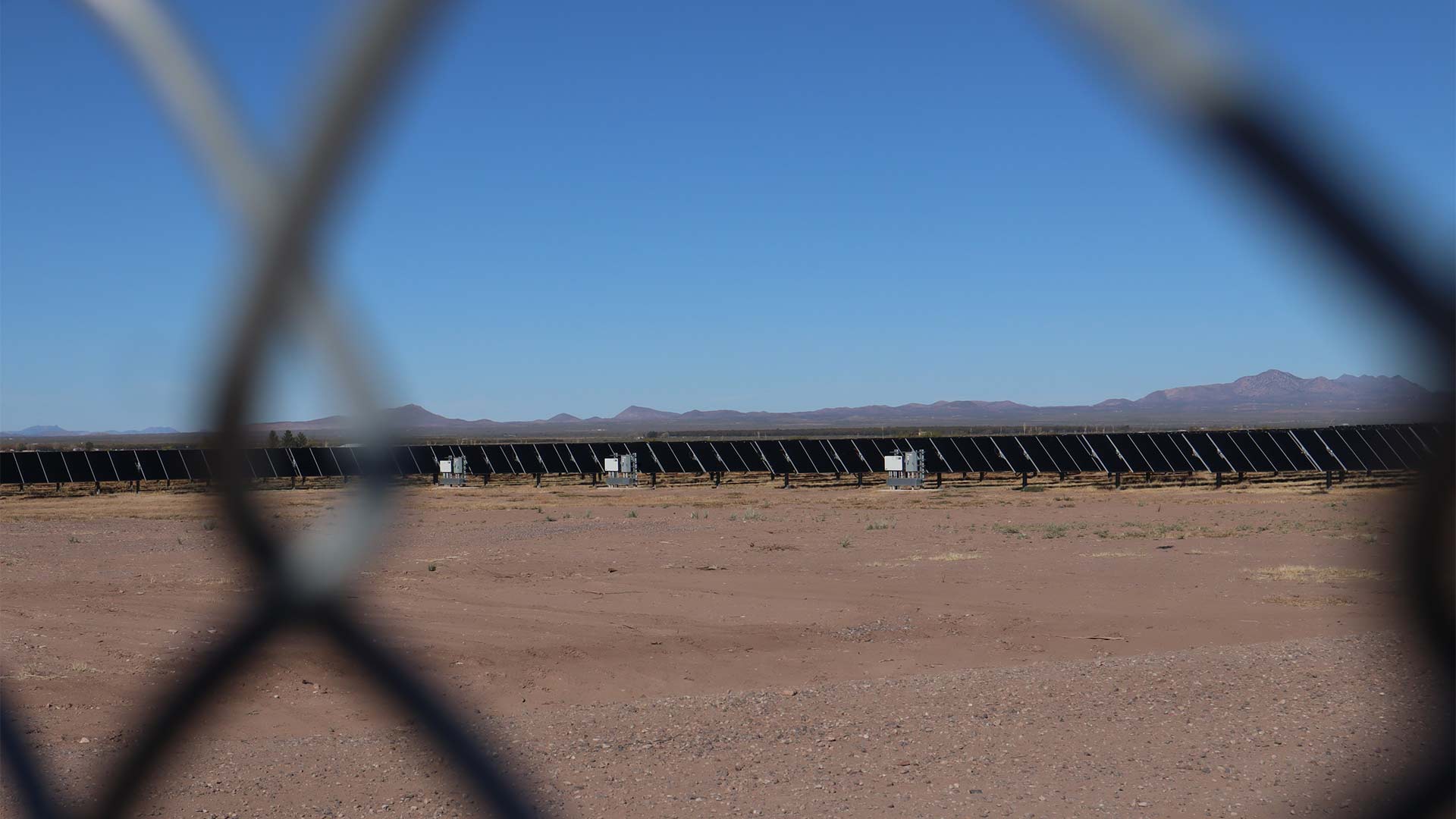 Solar panels from the McNeal solar farm owned by Silicon Ranch, a solar company based out of Tennessee. Silicon Ranch and Sulphur Springs Valley Electric Cooperative partnered together on the project and added a new SSVEC substation near the solar farm.
Solar panels from the McNeal solar farm owned by Silicon Ranch, a solar company based out of Tennessee. Silicon Ranch and Sulphur Springs Valley Electric Cooperative partnered together on the project and added a new SSVEC substation near the solar farm.
More than 60,000 solar panels now cover 160 acres of land near the town of McNeal, about 20 miles north of Douglas. It's the result of a joint partnership between a local electric cooperative and a Tennessee-based solar company to bring more solar power to a couple thousand homes.
“We’ve got a 20-megawatt solar farm here," said Daniel Wilson, Sulphur Springs Valley Electric Cooperative’s Senior Vice President of Operations. "It can power about 3,000 homes in this area ... And we also have it join with an 80-megawatt-hour battery, which will extend the output of the solar field up to four hours in the evening after the sun goes down.”
CEO of Sulphur Springs Valley Electric Cooperative Jason Bowling said that SSVEC has a purchase-power agreement with Silicon Ranch, the solar company based out of Tennessee that owns the solar farm. According to the cooperative’s press release, it is the first solar farm the Tennessee-based solar company has in Arizona.
"We’re able to buy it at a fixed price for the life of the contract,” said Bowling, who said negotiations with Silicon Ranch began a couple of years ago. “We’re able to help ensure that members are getting affordable energy. And so, locking in a three-cent-per-kilowatt-hour, roughly, price that they’re delivering to us keeps the overall cost down.”
Wilson said prior to the construction of the solar farm and new SSVEC substation, which completed in October and is located at the corner of West Bagby Road and Central Highway, most of the power came from fossil fuels.
"So about 10-years ago, we were … delivering roughly 80 percent coal power," said Wilson. "And there's a coal power plant about 60 miles north of here, and that provided most of our power. And we’ve recently gone down a path to diversify that. We’ve invested more in natural gas generated power and solar power. Solar power is great, but the sun doesn’t shine at night, so you need that natural gas to pick up the shoulders and the pieces that the solar power can’t provide. So, they make a very good partnership."
Wilson said the solar field not only feeds power to the McNeal substation, but also pushes power up to the cooperative's transmission grid to feed its other substations.
"The solar panels here produce enough power to feed about three of our substations in this area during winter and about two during the summer," said Wilson.
As part of the project, SSVEC also upgraded its McNeal substation. Bowling said the electric cooperative wanted to upgrade the substation to re-locate it next to the solar farm and to upgrade the infrastructure.
"The old substation is quite old and didn't have the capability of doing what this one does, to dump the power it generates out to our system," Bowling said. "Why here specifically? Inexpensive land is really critical to keeping costs down on the generation we provide. There's a little bit of strategy in ensuring that we have this generation in this pocket of our service territory, because it's so far away from everything else."
As to how power reaches members' homes, Wilson said substations like the one near McNeal, are like interchanges along an interstate highway.
"Just like an interstate highway, the transmission grid would be, essentially an express line and transmit power on long distances from generation station to generation station," said Wilson. "Along the way, we have substations, which are, like, interchanges on an interstate highway. And those substations allow you to transform the energy to a lower voltage that serves members, and those lower-voltage lines are like the feeder streets inside of a town or a city.”
Bowling said that SSVEC has one other partnership that has a 20-megawatt solar facility near Arizona Electric Power Cooperative's Substation. Wilson said that SSVEC also partnered with AEPCO and another solar company to develop a 235 megawatt solar facility.
"We partnered with AEPCO, who partnered with another solar developer, to develop a 235 megawatt solar facility that will be very similar to this; it will be solar and batteries," said Wilson. "But a little over 10-times as big. And we will be participating in 25% of that. So when that project is done along with this project and our other previous projects, we'll have about 30-35% solar energy on our system."

By submitting your comments, you hereby give AZPM the right to post your comments and potentially use them in any other form of media operated by this institution.